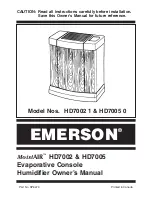
8. Operation
- 47 –
8. Operation
Level 1 Controllers. Refer to Tables 7-4 and 7-5 for time
sequences for Level 2 Controllers.
8.2.8.1
Valves – Mode
ls 40 through
450
•
Inlet switching valves are normally open, pneumatically
piston-actuated, Y-angle poppet valves. A yellow indicator
can be seen through a clear window at the top of the
actuator housing when the valve is in the open position.
•
Purge/repressurization valves are normally closed,
pneumatically piston-actuated, Y-angle poppet valves. A
yellow indicator can be seen through a clear window at
the top of the actuator housing when the valve is in the
open position.
•
12 volt DC, normally-closed, 3-way pilot solenoid valves
are wired to the controller and are used to direct pilot air
to the actuators of the inlet switching and
purge/repressurization valves.
•
Pressure differences between the online and offline
desiccant towers cause the outlet shuttle valve to shift.
•
Purge pressure and subsequent flow is adjusted by
means of a quarter-turn ball valve located in the bypass
line of the upper piping
•
Models 40 through 450 are equipped with a single safety
relief valve that has been sized at a minimum to provide
overpressure protection due to a fire for both desiccant
towers.
8.2.8.2
Valves – Mod
els 590 through
5400
•
Inlet switching valves are resilient seated butterfly valves
with double acting pneumatic rack and pinion actuators.
A yellow arrow indicator located on the top of the actuator
output shaft points to valve position indicator icons. Pilot
air is directed to actuator ports to open both inlet valves
upon loss of power.
•
Purge/repressurization valves are resilient seated
butterfly valves with spring return, fail closed, pneumatic
rack and pinion actuators. A yellow arrow indicator
located on the top of the actuator output shaft points to
valve position indicator icons. Pilot air is directed to
actuator ports to close both purge/repressurization valves
upon loss of power.
•
12 volt DC, single solenoid, 4-way pilot valves are wired
to the controller and are used to direct pilot air to the
actuators of the inlet switching and purge/repressurization
valves.
•
Two mainline outlet and two smaller purge line check
valves are installed in the upper piping to control the flow
of outlet and purge air. Check valve sticking will result in
excessive air discharge through a muffler. Excessive air
discharge through the muffler can be associated with a
leaking outlet check valve on the same side or a purge
check valve of the opposite side tower.
•
Purge pressure and subsequent flow is adjusted by
means of a throttling globe valve located in the bypass
line of the upper piping
•
Models 590 through 5400 are equipped with multiple
safety relief valves that have been sized to provide
overpressure protection for capacities equal to or greater
than the adjusted capacity of the dryer at its maximum
operating pressure.
•
The tower pressure gauge of the online tower should read
line pressure. Air should not be leaking from the purge-
repressurization valve of the on-line tower.
•
The tower pressure gauge of the offline tower should read
below 2 psig (0.14 kgf/ cm
2
) while that tower is purging. If
excessive air is exhausting during the purge cycle, the
inlet-switching valve on the same side may have failed to
close or a check valve may be sticking.
8.3
Operating Se
quence
8.3.1
Operating se
quence –
Level 1 Con
trollers
The operating sequence for dryers equipped with Level 1
Controllers appears in Tables 6.3 and 6.4.
8.3.2
Operating se
quence – L
evel 2 Con
trollers
The operating sequence for dryers equipped with Level 2
Controllers appears in Tables 7-2, 7-4, and 7-5.
8.4
Dryer Shut D
own
•
If the dryer installation is equipped with dryer bypass and
inlet and outlet isolation valves, the bypass valve should be
opened and the inlet and outlet isolation valves closed.
•
De-pressurize the dryer by allowing the controller to run
through tower change cycles until pressure gauges on both
towers read zero. Manual test mode may be used to speed
up this process. NOTE: Below 60 psig (4.22 kgf/ cm
2
)
purge/repressurization valves may not open. Opening the
manual drain on the pilot air filter or any mounted pre or
afterfilters may bleed off remaining pressure.
•
Turn dryer off using on-off switch (indicating LEDs
extinguished).
8.5
Loss of Power
Control valves are designed so that upon loss of power the air
dryer is capable of drying air until the desiccant exposed to the
airflow is saturated.
8.6
O
perating Parameters
Verify that dryer is operating within the following design
parameters:
8.6.1
Maximum Op
erating Pressure
(MOP):
•
150 psig (10.5 kgf/cm
2
) is standard.
•
250 psig (17.6 kgf/cm
2
) is optional.
Refer to Dryer Serial Number Tag.
WARNING - Do not operate the dryer at pressures above the
maximum operating pressure shown on the serial number tag.
NOTE: Consult factory for applications requiring higher
maximum operating pressures.
Содержание DGH Series
Страница 12: ...4 Installation 12 4 Installation Figure 4 3 continued on next page 590 5400 SCFM General Arrangement...
Страница 22: ...6 Controller Level 1 22 6 Controller Level 1 Figure 6 2 Electrical Schematic Level 1 Controller...
Страница 23: ...6 Controller Level 1 23 6 Controller Level 1 Figure 6 3 Point to Point Connection Diagram Level 1 Controller...
Страница 24: ...6 Controller Level 1 24 6 Controller Level 1 Figure 6 4 continued on next page Panel Layouts Level 1 Controller...
Страница 39: ...7 Controller Level 2 39 7 Controller Level 2 Figure 7 2 Electrical Schematic Level 2 Controller...
Страница 42: ...7 Controller Level 2 42 7 Controller Level 2 Figure 7 4 continued on next page Panel Layout Level 2 Controller...










































